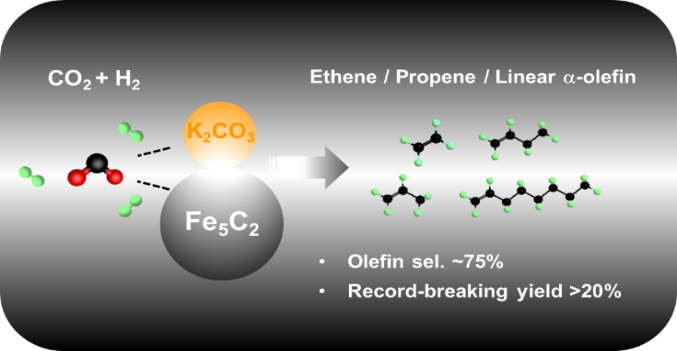The utilization of fossil fuels causes massive carbon dioxide (CO2) emissions, bringing about detrimental climate changes. The assistance of hydrogen from clean energy, such as nuclear, wind, solar, converting CO2 into regenerated valuable chemicals not only facilitates alleviating CO2 emissions, but also provides value-added products as industrial necessities.
The existence of alkali metal promoters such as K and Na can enhance the surface basicity and carburization of iron-based catalyst, making the catalyst active for CO2 hydrogenation to olefins. However, the primary active sites and the possibility to maximize the yield towards high-valued olefins via CO2 hydrogenation remain a challenge.
Recently, a research group led by Prof. SUN Jian and Prof. GE Qingjie from the Dalian Institute of Chemical Physics (DICP) of the Chinese Academy of Sciences revealed the interface effect in the catalytic hydrogenation of carbon dioxide.
"We found that carbonaceous K promoters could induce iron-based catalysts to form a unique and highly active Fe5C2-K2CO3 interface during the process of carbon dioxide hydrogenation, and it could improve the production of high-valued olefins," said Prof. SUN.
This work was published in ACS Catalysis on Aug. 26.

CO2 molecules improve the migration ability of carbonaceous K-promoters to form more Fe5C2-K2CO3 interface (Image by HAN Yu and SUN Jian)
A high olefin selectivity of near 75% in hydrocarbons was realized at a conversion of more than 32%. The maximum yield of high-valued olefins reached up to 20.1%.
According to characterization results, the CO2 molecules participating in the interconversion of potassium bicarbonate-formate could improve the migration ability of carbonaceous K-promoters and form more Fe5C2-K2CO3 interface, resulting in the high selectivity of high-valued olefins (HVO) from CO2 hydrogenation.
In addition, the appropriate proximity between K2CO3 and Fe/C catalyst enabled the catalytic system with an outstanding yield of high-valued olefins and high catalytic stability.
These findings enrich the chemistry of CO2 conversion, and provide a strategy to designing highly selective catalysts for high-valued chemicals.
This work was supported by the National Natural Science Foundation of China, Liaoning Revitalization Talents Program, the "Transformational Technologies for Clean Energy and Demonstration", Strategic Priority Research Program of the Chinese Academy of Sciences, and the Youth Innovation Promotion Association of Chinese Academy of Sciences. (Text by HAN Yu and SUN Jian)